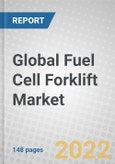Report Scope
This report analyses different technologies, applications, and regional market development in the fuel cell forklifts market. This report also covers the market analysis for countries such as the U.S., China, Japan, and others, where the opportunities for fuel cell forklifts are lucrative. However, deployment data for fuel cell forklifts are not available for all countries.
The report is prepared in a simple, easy-to-understand format; tables and figures are included to illustrate historical, current, and future market scenarios. The report also covers leading companies with information on product types, business footprint, revenue, employee strength, etc. We have also covered a list of other companies in the global and regional market with their product-related information. Aside from this, the analyst has also covered the patent analysis for the fuel cell forklift market.
We have included inflation in the product pricing which is reflected in the market value of the historic year, while the forecasted values are nominal values.
The report also examines the impact of COVID-19 on the global and regional levels. 2021 is considered a historic/base year, 2022 is an estimated year, and the market values are forecasted for five years until 2027. All market values are in the dollar ($) million and volume is measured in units.
Report Includes
- 33 data tables and 16 additional tables
- A brief general overview of the global markets for fuel cell forklifts within the industry
- Analyses of the global market trends, with market revenue for 2021, estimates for 2022, 2024, and 2026, along with the projections of compound annual growth rates (CAGRs) through 2027
- Estimation of the actual market size for fuel cell forklift technology, market forecast in value and volumetric terms, and corresponding market share analysis based on technology type, application, power capacity, and region
- Updated information on market opportunities and drivers, key shifts and regulations, industry-specific challenges, and other region-specific macroeconomic factors that will shape this market demand in the coming years (2022-2027)
- Coverage of the technological, economic, and business considerations of the fuel cell forklift market and its vendor landscape
- Discussion of the industry value chain analysis providing a systematic study of key intermediaries involved, with emphasis on recent developments and regulations and standards for fuel cell forklifts
- Review of registered patents filed on various technologies for fuel cell forklifts during 2020-2022, and their corresponding patent share analysis
- Insight into the company's competitive landscape featuring top players in the eco-structure of the fuel cell forklift industry, their recent market developments and key strategies adopted
- Descriptive company profiles of the leading global players, including Air Liquide S.A., Hyster-Yale Materials Handling Inc., Kion Group AG, and Plug Power Inc.
Table of Contents
Executive Summary
Fuel cells are the future technology which can alter conventional energy sources such as gasoline, diesel, LPG, and others, in the coming decades. Fuel cells are being used in the material handling industry as these cells are more efficient than conventional technologies. Fuel cell forklifts require only 2-3 minutes to refuel. While traditional battery-powered forklifts require around 3-5 hours to recharge the battery. The battery swapping is also a time-consuming task requiring labour and hoisting systems. Currently, the spendings on battery-powered forklifts are high compared to fuel cell forklifts. But, in ten-year operational time periods, fuel cell forklifts will be the less costly option to consumers, as
opposed to battery-powered forklifts. Therefore, retail industry companies such as Amazon and Walmart are using these forklifts to gain long-term benefits as they are experiencing an increase in their productivity.
Reasons for Doing This Study:
A fuel cell is a clean energy technology and can be used as green fuel in many industries, from automotive to medical to electronics. Pollution levels are increasing at an alarming rate and greenhouse gases have started to damage the environmental structure. Most countries are working towards the development and commercialization of clean fuels such as hydrogen, which does not emit any kind of harmful gases after burning. Historically, the material handling industry has been an important sector in GDP development for all countries. By using nonrenewable fuels, such as LPG, diesel, and gasoline, significant levels of harmful gases are generated which can affect the health of those working in warehouses and factories. Therefore, forklift users are also shifting to the use of battery power forklifts; however, these forklifts require a dedicated space in the warehouse for battery storing, recharging, and swapping. For warehouses, retailing centres, plants, factories, and others, productivity is the key criteria for generating revenue. Therefore, forklift users are showing interest in using fuel cell forklifts as they take less time to refuel and the overall expenditure for these forklifts is comparatively less over a 10-year period.
Due to these changes and the rising adoption of hydrogen-powered forklifts, the publisher has decided to analyze the market and measure the impact of these advanced forklifts on the conventional forklift market.
Companies Mentioned
- Air Liquide S.A.
- Anhui Heli Co. Ltd.
- Auriga Energy Ltd.
- Ballard Power Systems Inc.
- Beijing Sinohytec Co. Ltd.
- Hyster-Yale Materials Handling Inc.
- Johnson Matthey
- Kion Group AG
- Nel Asa
- Plug Power Inc.
- Proton Motor Fuel Cell GmbH
- Shanghai Pearl Hydrogen Energy Technology Co. Ltd.
- Toyota Material Handling Europe
Table Information
| Report Attribute | Details |
|---|---|
| No. of Pages | 148 |
| Published | August 2022 |
| Forecast Period | 2022 - 2027 |
| Estimated Market Value ( USD | $ 427.1 Million |
| Forecasted Market Value ( USD | $ 1397.4 Million |
| Compound Annual Growth Rate | 26.8% |
| Regions Covered | Global |
| No. of Companies Mentioned | 13 |









